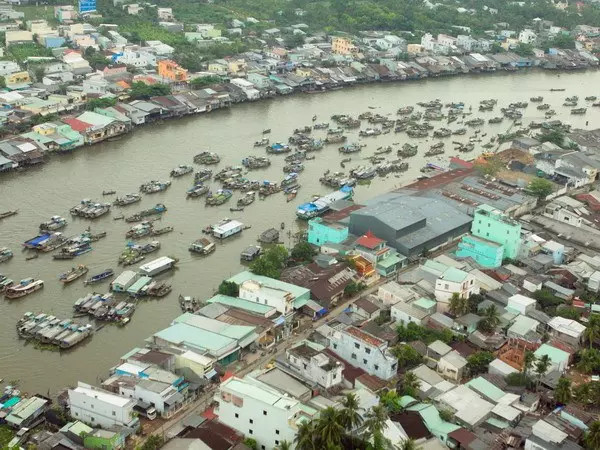
Professor Nguyen Ngoc Tran discusses his thoughts on Mekong Delta regional planning below. He is former Vice Chairman of State Committee for Science and Technology, Head of State Scientific Program for General Basic Survey of the Mekong Delta.
Mekong Delta, belonging to the southern key economic zone, is one of six socio-economic regions of the country, comprising 13 centrally run provinces/cities with total area of 40,600 square kilometers, which account for 13 percent of the country’s total natural area. This includes 1.5 hectares of the most fertile rice-growing land in Vietnam and the world. The population of the region is 17.5 million, accounting for 18 percent of the country’s population.
This is a region with a particularly important strategic position, with important geopolitics, geo-economics and geo-military significance for the country. The region is adjacent to the East-West maritime route, with important international air and maritime traffic, connecting South Asia and East Asia as well as Australia and archipelagos in the Pacific Ocean.
The Mekong Delta region has great potential and advantages for development; is one of the largest, most fertile plains in Southeast Asia and the world; and is the largest production and export region of food and foodstuff, aquatic products and fruits of the country. It makes up 50 percent of rice production, 95 percent of rice exports, nearly 65 percent of seafood production, 60 percent of fish exports and nearly 70 percent of fruits.
This is also a region with a system of interlacing rivers, canals and many forests, the home of four biosphere reserves, national parks, and nature reserves recognized as Ramsar sites.
Big challenges
The Mekong Delta is one of the three largest deltas in the world most seriously threatened by climate change. The growth model depletes land resources, wastes water resources, impoverishes biodiversity and gradually erases natural ecosystems.
The soil in Mekong Delta is very weak. Natural subsidence, together with accelerated subsidence due to over-exploitation of groundwater and sand from construction and urbanization, has accelerated subsidence in the delta.
In terms of economy, there are three outstanding points. The infrastructure is poor and the transport network is incapable of transporting farm produce of the region, which leads to high logistics costs.
ODA (official development assistance) and FDI (foreign direct investment) capital allocated to Mekong Delta is the lowest among the six economic regions of the country.
The economies of 13 provinces and cities in Mekong Delta are run separately, with little support for each other. Sometimes they even compete with each other. The development of a regional economy for the entire Mekong Delta, which was mentioned 32 years ago, is still on paper.
Regarding socio-cultural development, the figures show worrying problems about human resources development.
The average population growth rate in 2009-2019 is the lowest in the country. The population aging index is the highest. The net migration rate is -39.9 percent, the highest in the country.
The literacy rate of the population aged 15 and over is the lowest in the country (94.2 percent vs 95.8 percent), just above the Central Highlands.
Sustainable development
A conference on developing the Mekong Delta in a sustainable way, adaptable to climate change, presided over by the Prime Minister was organized in Can Tho on September 26, 2017. Resolution 120 was issued on the basis of the results of the conference. There are two important guidelines.
First, changing development thinking, shifting from pure agricultural production, mainly rice production, to a diversified agricultural economy development, meeting the needs of the market.
Second, respecting natural laws, not aggressively interfering with nature, choosing production models adaptable to nature, and living together with floods, brackish and saltwater.
Resolution 120 marked a turning point in the history of Mekong Delta development.
Regional planning
The master plan for Mekong Delta development has been approved by the Prime Minister. Adaptation to climate change and sustainability are big questions for the Government and the National Assembly.
The regional plan must be an integrated multi-sectoral plan, because natural elements are linked and interact with each other. They are not subject to administrative boundaries.
Regional planning needs to ensure harmonization between the immediate and long-term benefits when exploiting regional resources.
It is necessary to apply scientific and technological advances such as wind and solar power, which have completely changed the view about the potential of Ninh Thuan.
The relations between the area and adjacent regions needs to be considered thoroughly when planning, because regional boundaries are artificial. The planning needs to be put above local interests.
Prof. Nguyen Ngoc Tran